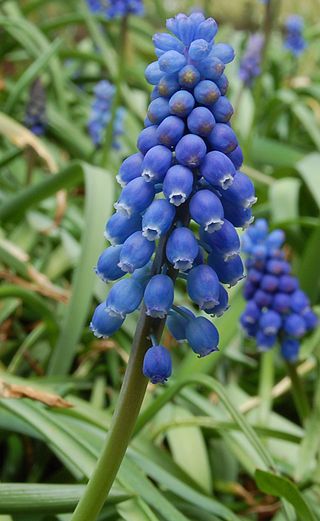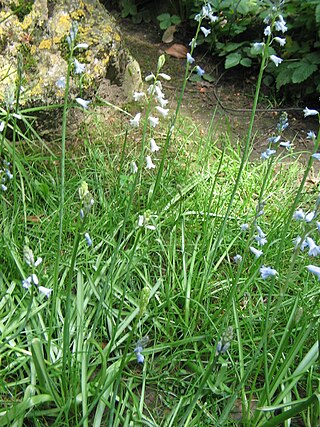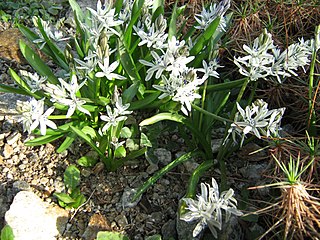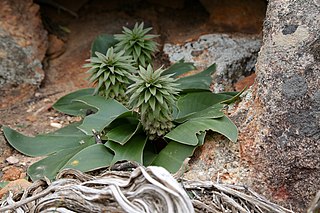
Hyacinthus is a small genus of bulbous herbs, spring-blooming perennials. They are fragrant flowering plants in the family Asparagaceae, subfamily Scilloideae and are commonly called hyacinths. The genus is native predominantly to the Eastern Mediterranean region and Afrotropical realm, although naturalized more widely.

Scilla is a genus of about 30 to 80 species of bulb-forming perennial herbaceous plants in the family Asparagaceae, subfamily Scilloideae. Sometimes called the squills in English, they are native to woodlands, subalpine meadows, and seashores throughout Europe, Africa and the Middle East. A few species are also naturalized in Australasia and North America. Their flowers are usually blue, but white, pink, and purple types are known; most flower in early spring, but a few are autumn-flowering. Several Scilla species are valued as ornamental garden plants.

Scilloideae is a subfamily of bulbous plants within the family Asparagaceae. Scilloideae is sometimes treated as a separate family Hyacinthaceae, named after the genus Hyacinthus. Scilloideae or Hyacinthaceae include many familiar garden plants such as Hyacinthus (hyacinths), Hyacinthoides (bluebells), Muscari and Scilla and Puschkinia. Some are important as cut flowers.

Muscari is a genus of perennial bulbous plants native to Eurasia that produce spikes of dense, most commonly blue, urn-shaped flowers resembling bunches of grapes in the spring. The common name for the genus is grape hyacinth, but they should not be confused with hyacinths. A number of species of Muscari are used as ornamental garden plants.

Bellevalia is a genus of plants in the family Asparagaceae, subfamily Scilloideae. It was first described as a genus in 1808.

Scilla luciliae is a species of flowering plant in the family Asparagaceae. It is referred to by the common names Bossier's glory-of-the-snow or Lucile's glory-of-the-snow, and is a bulbous perennial from western Turkey that flowers in early spring. After flowering, it goes into dormancy until the next spring. The specific epithet is in honour of Lucile, the wife of the Swiss botanist Pierre Edmond Boissier (1810-1885). It belongs to a group of Scilla species that were formerly put in a separate genus, Chionodoxa, and may now be treated as Scilla sect. Chionodoxa.

Puschkinia is a genus of four known species of bulbous perennials in the family Asparagaceae, subfamily Scilloideae. It is native to the Caucasus and the Middle East. Puschkinia scilloides is grown as an ornamental bulbous plant.

Scilla section Chionodoxa, known as glory-of-the-snow, is a small group of bulbous perennial flowering plants in the family Asparagaceae, subfamily Scilloideae. Formerly treated as the separate genus Chionodoxa, they are now included in Scilla as a section. The section is endemic to the eastern Mediterranean, specifically Crete, Cyprus and Turkey. The blue, white or pink flowers appear early in the year making them valuable garden ornamentals. The common name of the group is based on the habit of flowering in high alpine zones when the snow melts in spring.

Brimeura is a genus of bulb-forming, monocotyledonous perennial plants. They have narrow leaves and bear bluebell-like flowers in Spring. Brimeura is treated in the family Asparagaceae, subfamily Scilloideae, tribe Hyacintheae, subtribe Hyacinthinae. It contains the following species

Scilla sardensis, the lesser glory-of-the-snow, is a bulbous perennial from west Turkey flowering in early spring. After flowering, it goes into dormancy until the next spring. It belongs to a group of Scilla species that were formerly put in a separate genus, Chionodoxa, and may now be treated as Scilla sect. Chionodoxa.

Scilla nana, known as dwarf glory-of-the-snow, is a bulbous perennial flowering plant endemic to Crete. It flowers in early spring with flowers in shades of lilac blue. After flowering, it goes into dormancy until the next spring. It belongs to a group of Scilla species that were formerly put in a separate genus, Chionodoxa, and may now be treated as Scilla sect. Chionodoxa. It has not always been recognized as distinct from Scilla cretica.
Colchicum lingulatum is a species of flowering plant in the Colchicaceae family. It is native to north-western Turkey and to Greece. Colchicum lingulatum blooms in early autumn, with pink flowers approximately 3–4 cm in size, with widely spaced petals. The stamens are a prominent yellow. The foliage begins to grow after the flowers.
Alrawia is a genus of bulbous flowering plants in the family Asparagaceae, subfamily Scilloideae. It is native to north-eastern Iraq and Iran.

Barnardia is a small genus of bulbous flowering plants in the family Asparagaceae, subfamily Scilloideae. The genus has two species, one found in the Balearic Islands and north-west Africa, the other in east China, Korea, Japan and adjacent localities. It was suggested in 2012 that the two species were not closely related.

Daubenya is a genus of bulbous flowering plants in the family Asparagaceae, subfamily Scilloideae. It is native to the Cape Province of South Africa. At first believed to consist of a single species, Daubenya aurea, the genus was expanded in 2000 to include the genera Androsiphonand Amphisiphon and various species that had previously been classified as Polyxena, Massonia, or Neobakeria. "The poor congruence between morphological and other characters within Hyacinthaceae has also made generic circumscriptions very difficult. One of the consequences of this has been the recognition of a large number of genera that are poorly defined morphologically."-

Dipcadi is a genus of bulbous flowering plants in the family Asparagaceae, subfamily Scilloideae. It is widely distributed, occurring in southern Europe, most of Africa and the Middle East through to the Indian subcontinent.

Fessia is a genus of bulbous flowering plants in the family Asparagaceae, subfamily Scilloideae. It is distributed from Iran to Central Asia and Pakistan.

Merwilla is a genus of bulbous flowering plants in the family Asparagaceae, subfamily Scilloideae. It is distributed in southern Africa, from Zimbabwe to South Africa. This genus is named after the botanist Frederick Ziervogel Van der Merwe (1894–1968), who worked on this group.
Scilla cretica is a species of flowering plant in the Asparagaceae family. It is referred to by the common name Cretan glory-of-the-snow, and is a bulbous perennial native to Crete, flowering in early spring. It belongs to a group of Scilla species that were formerly put in a separate genus, Chionodoxa, and may now be treated as Scilla sect. Chionodoxa. It has not always been recognized as distinct from Scilla nana.

Eucomis regia is a species of bulbous flowering plant in the family Asparagaceae, subfamily Scilloideae, native to the Cape Provinces of South Africa. It is sometimes cultivated, but requires protection in a greenhouse in temperate climates.

















